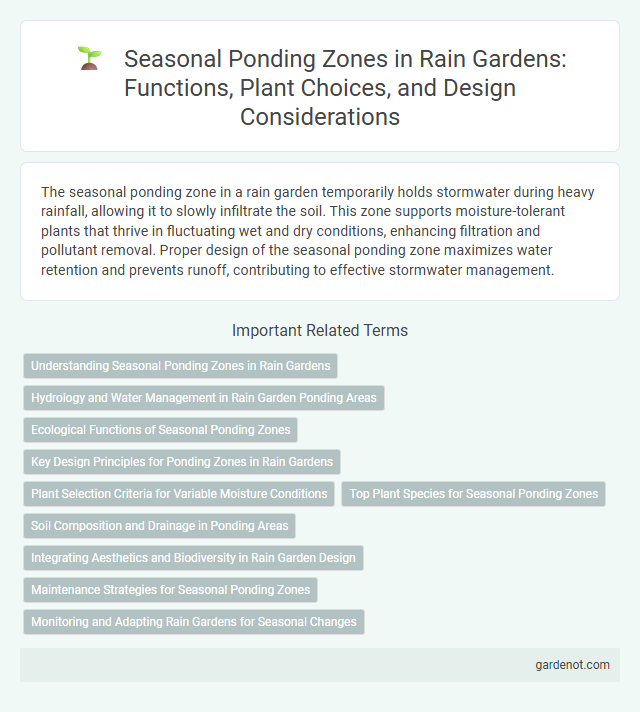The seasonal ponding zone in a rain garden temporarily holds stormwater during heavy rainfall, allowing it to slowly infiltrate the soil. This zone supports moisture-tolerant plants that thrive in fluctuating wet and dry conditions, enhancing filtration and pollutant removal. Proper design of the seasonal ponding zone maximizes water retention and prevents runoff, contributing to effective stormwater management.
Understanding Seasonal Ponding Zones in Rain Gardens
Seasonal ponding zones in rain gardens temporarily hold rainwater, promoting infiltration and reducing runoff during wet periods. These zones are designed to accommodate water storage for 12 to 48 hours, enhancing soil moisture and supporting native plant growth adapted to fluctuating wet-dry cycles. Proper understanding of seasonal ponding depth and duration optimizes rain garden performance and minimizes erosion.
Hydrology and Water Management in Rain Garden Ponding Areas
The seasonal ponding zone in rain gardens plays a crucial role in hydrology by temporarily storing stormwater runoff, allowing for infiltration and reducing peak flow rates. This ponding area supports water management by promoting sedimentation, nutrient uptake, and microbial activity, which improve water quality before it percolates into the soil. Effective design of the ponding zone enhances groundwater recharge and mitigates urban flooding through controlled detention of rainwater.
Ecological Functions of Seasonal Ponding Zones
Seasonal ponding zones in rain gardens create temporary wetlands that support diverse aquatic and terrestrial species by providing critical habitat during rainy periods. These zones enhance water quality through sediment settling, nutrient uptake, and microbial activity, reducing pollutants before infiltration or downstream discharge. By mimicking natural hydrological cycles, seasonal ponding zones contribute to groundwater recharge and mitigate urban runoff impacts.
Key Design Principles for Ponding Zones in Rain Gardens
The seasonal ponding zone in rain gardens is designed to temporarily retain stormwater runoff, promoting infiltration and pollutant removal. Key design principles include ensuring a shallow depth of 3 to 6 inches, using native wetland plants to enhance water uptake, and incorporating an impermeable liner or clay layer beneath to prevent groundwater contamination. Proper sizing, typically 10-25% of the total rain garden area, ensures adequate detention time for sedimentation and biological treatment.
Plant Selection Criteria for Variable Moisture Conditions
The seasonal ponding zone in a rain garden experiences fluctuating moisture levels, requiring plants with high tolerance to both wet and dry conditions. Ideal species include native sedges, rushes, and wetland wildflowers that can withstand intermittent flooding and periods of drought. Selecting plants with deep root systems enhances water infiltration and soil stabilization, optimizing rain garden performance across variable moisture cycles.
Top Plant Species for Seasonal Ponding Zones
Top plant species for seasonal ponding zones in rain gardens include Carex vulpinoidea (Fox Sedge), Juncus effusus (Soft Rush), and Lobelia cardinalis (Cardinal Flower), which thrive in intermittent standing water. These hydrophytic plants exhibit high tolerance to fluctuating moisture levels and contribute to enhanced water filtration and erosion control. Selecting native species adapted to seasonal inundation promotes biodiversity and ensures sustainable rain garden performance.
Soil Composition and Drainage in Ponding Areas
The seasonal ponding zone in a rain garden is designed with a soil composition that balances organic matter, sand, and clay to optimize water retention while ensuring efficient drainage. This zone temporarily holds runoff, allowing it to infiltrate slowly into the subsoil, preventing erosion and reducing surface water accumulation. Proper soil porosity and permeability within the ponding area are crucial for maintaining healthy plant growth and sustaining water quality by filtering pollutants.
Integrating Aesthetics and Biodiversity in Rain Garden Design
The seasonal ponding zone in rain gardens serves as a critical habitat supporting diverse aquatic and semi-aquatic plants that enhance both aesthetic appeal and ecological function. By selecting native species adapted to periodic inundation, designers can create visually dynamic landscapes that attract pollinators, amphibians, and birds, promoting biodiversity. Effective integration of this zone fosters natural water filtration and shifts through wet and dry cycles, supporting a resilient and sustainable stormwater management system.
Maintenance Strategies for Seasonal Ponding Zones
Seasonal ponding zones in rain gardens require regular removal of debris and sediment to maintain proper water infiltration and prevent clogging. Monitoring vegetation health and replacing dead plants ensures sustained filtration and habitat provision throughout varying water levels. Routine inspection after heavy rainfall helps identify erosion or ponding issues, enabling timely repairs to maintain optimal performance.
Monitoring and Adapting Rain Gardens for Seasonal Changes
The seasonal ponding zone in rain gardens must be closely monitored to evaluate water retention and drainage efficiency during varying weather patterns. Regular assessment of soil moisture levels and plant health enables timely adjustments such as modifying soil composition or selecting resilient native species to enhance absorption capacity. Adapting rain garden design to seasonal changes ensures optimal performance in managing runoff and promoting sustainable urban water management.
Seasonal ponding zone Infographic

 gardenot.com
gardenot.com